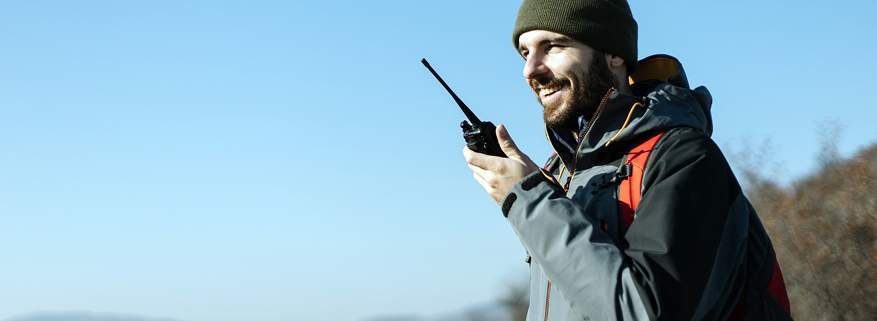CB Radio Cheat Sheet

In large portions of the Australian outback, there’s no cell coverage. Cell towers cover 99.9% of the resident population, but residential areas only cover a small percentage of Australia. A CB Radio is a great tool for campers, as it provides 80 channels of communication and doesn't require a license. A CB radio means you can communicate with other vehicles and with emergency services almost anywhere.
There are strict laws governing the use of citizens’ band radios and hefty fines or jail time can apply for misuse. The main channels you will be using are 18, 10, or 40 if you need to get in touch with a caravanner/camper, 4WD vehicle, or a truck driver. If you’re a caravanner/camper channel 18 is where you should be hanging out. If something falls off your camper, this is how someone will find you!
How To Use a CB
- Hold the transmit button on the side of your radio or handpiece, position the microphone 5 to 10cm from your face; and wait one second before beginning your transmission. This will avoid your voice being cut off.
- When you’ve finished talking, release the transmit button. Unlike telephone communication, users can’t transmit simultaneously – so always wait for others to finish their message before replying.
- If you are receiving a weak signal, try turning the squelch level down to hear them. Squelch is the function which silences weak or noisy transmission.
There are a number of CB radio channels you can switch to for getting shared information. The channels in blue are more likely the ones you will be using when on your trek.
UHF CB Radio Channels & Use
| Channel | Used for |
|---|---|
| 1 - 4 | Duplex channels (output). [avoid] |
| 5 | Duplex channels are strictly used for emergency communications. [in the UHF band] But you can use any CB frequency to attract attention in an emergency. |
| 6-8 | Duplex channels (output). [avoid] |
| 9 | General chat channels [simplex] |
| 10 | 4WD Clubs or Convoys and National Parks. |
| 11 | Meet Up, then Move On |
| 12-15 | General chat channels [simplex] |
| 16 | Meet Up, then Move On |
| 17 | General chat channels [simplex] |
| 18 | Caravanners and Campers Convoy Channel. |
| 19-21 | General chat channels [simplex] |
| 22-23 | Telemetry & Telecommand used for automated data communications only. [do not use] |
| 24-28 | General chat channels [simplex] |
| 29 | Road safety channel Pacific Hwy, Pacific Mwy (NSW & QLD). [do not use] |
| 30 | General chat channels [simplex] |
| 31-34 | Duplex channels (input). [avoid] |
| 35 | Duplex channels are strictly used for emergency communications. [in the UHF band] But you can use any CB frequency to attract attention in an emergency. |
| 36-38 | Duplex channels (input) . [avoid] |
| 39 | General chat channels [simplex] |
| 40 | Australia Wide road safety channel used primarily by truckers and oversized load pilot vehicles. |
| 41-48 | Duplex channels (output). [avoid] |
| 49-60 | General chat channels [simplex] |
| 61-63 | Reserved for future use. [do not use] |
| 64-70 | General chat channels [simplex] |
| 71-78 | Duplex channels (input). [avoid] |
| 79-80 | General chat channels [simplex] |
UHF CB Radio Etiquette
- Keep off legislated or legally restricted channels 22, 23, 61, 62 and 63.
- Channel 5, 35 and 11 should only be used when it is absolutely necessary.
- Once you have established contact on channel 11, you should move to a different channel to continue your conversation.
- Communications on public channels can be heard by any user or repeater you are using within range, and could join in.
- When you encounter trolls, don't engage them. When you come across new users (newbies) who don’t know how to behave yet, politely inform them about radio etiquette.
- If someone else is talking, wait a few seconds before replying in case someone needs to butt in with an emergency call.
- The microphone works best if held forward of your cheek so you talk across the microphone.
- Pressing the transmit button doesn't mean there is an instantaneous transmission. Pause for a second, or the receiver may miss the first word or two.
Radio Talk
- copy, copy that or 10-4 = you have received the message and understood it
- over = a punctuation point to say your message is ending and for the next person to have their say
- roger = “okay” or “message received”
- affirmative = “yes”
- negative = “no”
Range / Distance
UHF CB operates on a line-of-sight basis, therefore it can have a very short reach. Expect a good signal for about 5 - 8km under normal conditions, but it can be increased to up to 25km on a higher elevation, such as a hill.
Simplex function: on non-duplex channels, directly between radio sets without the use of a repeater.
Duplex function: helps increase the range of UHF radios using repeater stations set in ideal locations, such as hills. In duplex mode, the fixed position station forwards the signal it receives from repeater input stations 31-38 & 71-78 to the corresponding output stations 1-8 & 41-48.
30 Jul 2021

